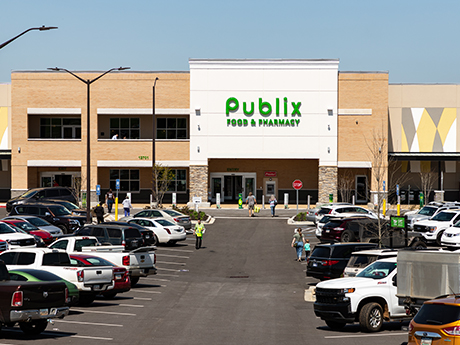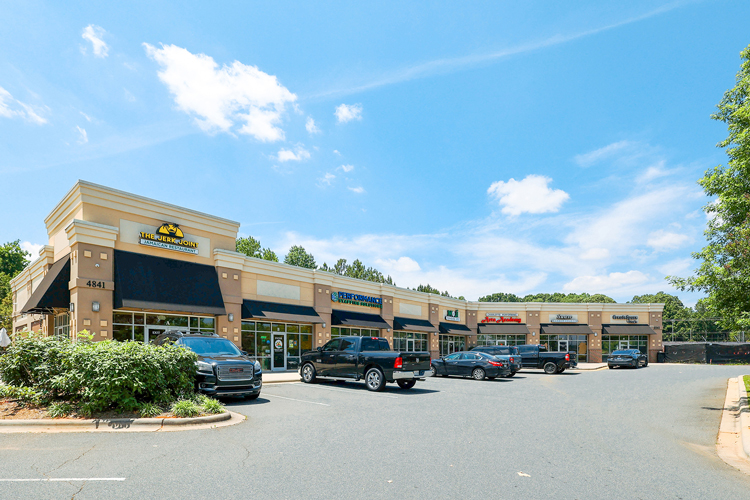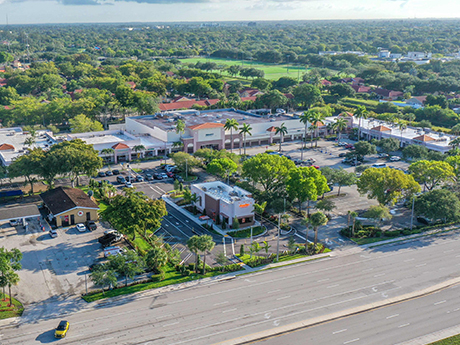The U.S. retail market is currently on a long stretch of rock-solid performance at the property level. The national vacancy rate is at a healthy 4.1 percent, according to first-quarter 2024 research from CoStar Group. This comes one quarter after a stellar 4 percent vacancy rate at year-end 2023.
What’s more is net store openings are on pace to be positive for the third consecutive year, according to research from Cushman & Wakefield. There have been more than 1,700 announced retail store closures thus far in 2024, with recent examples including Family Dollar, Express, Macy’s and 99 Cents Only. However, the number of announced closures has been outpaced by the more than 3,000 announced openings this year, including from the likes of Walmart, Academy Sports + Outdoors, Aldi and Target.
With tight occupancy, due in large part to limited retail deliveries compared to historical norms, plus the influence of stubbornly high inflation, rental rates are also peaking. Rental rates ended the year at about $25 per square foot, which is a 3 percent increase year-over-year, according to CoStar.
Matthew Mousavi, managing principal at SRS Real Estate Partners, says that retail real estate is performing so well that it now offers the best risk-adjusted return in commercial real estate, even more than the darling sectors of industrial and multifamily.
“Occupancy rates are at record levels and new construction for shopping centers is limited — vacancies are being backfilled very quickly for better rental rates,” says Mousavi, who is based in the firm’s Newport Beach, California, office. “The ‘retail apocalypse’ never occurred because everything got absorbed.”
Although the retail real estate market is blossoming in many ways, investment sales volume remains down drastically. According to research from Matthews Real Estate Investment Services, retail investment sales in 2023 totaled $53 billion, which is approximately 25 percent below the average annual sales volume over the trailing 10 years. The first quarter didn’t show much signs of improvement as it was the weakest quarter in terms of sales volume since 2013.
Mousavi says that his firm has brokered 121 retail property sales year-to-date, with another 107 under contract. While this level of transactional volume is respectable, Mousavi notes that investment sales volume has been dovetailing the past several quarters.
“Deals are certainly getting done, but it’s a challenging environment,” he says.
As mentioned, the retail sector’s underlying fundamentals are promising for both investors and lenders, which is a departure from the Great Financial Crisis and other down cycles. Generally speaking, worries of overbuilding, retailer issues or even lack of liquidity from debt and equity providers are largely absent in today’s retail landscape. So the buyers, while present, are stuck.
“The buyer pool is just waiting; it’s almost the opposite now from other downturns — there’s plenty of capital chasing retail real estate,” says Mousavi, noting that there’s very limited real-estate owned (REO) assets in the retail space.
“And in the absence of distress, sellers are just holding,” he says. “It’s a frozen market.”
Danny Finkle, senior managing director of JLL’s Miami office, also says there’s no shortage of willing buyers, adding that the buyer pool comprises private, institutional, public REITs and 1031 buyers active across all three main retail segments — single-tenant net lease (STNL), unanchored retail centers and larger grocery-anchored shopping centers.
“Buyers of retail centers are increasingly aggressive to acquire quality assets, benefit from the sector’s fundamental performance and achieve scale,” says Finkle, who is also co-head of JLL’s Miami office and leader of the firm’s retail group.
It’s also important to remember that traditional retail owners have other options outside of commercial real estate. Mousavi says that buyers can find better yield in alternative investments such as bonds, treasuries, CDs and money markets, which is keeping some market participants out of commercial real estate entirely for the time being.
“It’s all part of the recalibration,” says Mousavi. “There’s pain, it’s time consuming and it’s lowering valuations.”

The price isn’t right
The central friction between buyers and sellers is the mismatch on pricing, which is a direct result of the rapid acceleration of interest rates over the past two years. Over the course of 16 months between March 2022 and July 2023, the Federal Reserve raised the federal funds rate 11 times for north of 500 basis points.
Don McMinn, senior managing director of retail investments at Marcus & Millichap, says that the escalated borrowing costs and the unpredictability of future interest rate movements have stymied investment sales volume.
“There is an overabundance of capital but not a lot of deal flow because price discovery is making it hard for capital to find a home,” says McMinn, who also co-leads the company’s Taylor-McMinn Retail Group, based in Atlanta.
Zach Taylor, McMinn’s partner who is also a senior managing director at Marcus & Millichap, says that pricing is becoming even more burdensome due to the negative loop of fewer transactions, thus a lack in comparable sales data used in appraisals and broker opinions of value (BOVs).
“Without more transactions, price discovery is still underway,” says Taylor. “Transaction velocity and available inventory remains below historical averages. The 10-year Treasury yield stabilized in the first quarter but has been moving north.” (The 10-year Treasury yield settled around 4.6 percent at the time of this writing, up from 3.8 percent from the start of the year.)
The proverbial bid-ask gap, or the spread between what a willing buyer will pay a willing seller, all centers on cap rates. Buyers look to purchase properties with cap rates that exceed the financing’s underlying interest rates, which was much easier prior to the Fed’s rapid rate hikes.
Today, that is getting tougher as cap rates have risen, but not as much as interest rates. Greg Matus, senior vice president of investment sales in Franklin Street’s Fort Lauderdale office, says that retail cap rates have shown some variability over the past 12 months.
“Generally, there has been a slight rise in cap rates for well-performing assets, while those facing challenges or uncertainties have experienced the largest upward pressure on cap rates,” says Matus.
Mousavi says that cap rates are moving in the right direction to help grease the wheels for more investment sales but that it takes time for the market to catch up with the machinations of the Fed.
“Our industry is still going through a recalibration for the rate hikes,” says Mousavi. “Those rate hikes take time to permeate through the market and impact transactions. If you’re at an 8 cap as a buyer, I want a 6 cap as a seller. Cap rates are creeping up, but the market is not there yet. Investment sales volume is still down so in theory cap rates haven’t widened enough.”

A question of leverage
Mousavi says that the rate of upward movement in cap rates has slowed as of late, which has led to an interesting quandary for both buyers and sellers. Buyers that are eager to acquire shopping centers, single-tenant and other retail properties must at least entertain the idea of negative leverage (i.e. when interest rates exceed cap rates).
“Negative leverage is happening despite it not being the norm,” says Mousavi. “Debt buyers are having a hard time because they’re used to putting 30 percent down and financing the rest, but financing with negative leverage doesn’t make sense.”
Taking on negative leverage isn’t a viable path for most investors because it presupposes that the new ownership will be able to boost net operating income (NOI), which is a flimsy premise given the strong occupancy and rent growth in the retail sector.
Taylor says for buyers willing to take on negative leverage for the short-term there are “some good buys this year.”
One path forward that makes sense for some buyers is bank financing. Sources say that banks have pulled back from lending to retail borrowers outside of “no-brainer” deals that any capital provider would do. While not really meeting the definition of rescue capital technically, what banks are offering to borrowers willing to take on negative leverage is a way to swap short-term risk for long-term profitability.
“The terms aren’t great, but banks are offering no fees for refinancing,” says Mousavi. “So borrowers are thinking they can deal with short-term pain and refinance when rates come down.”
For sellers, the current impasse between interest rates and cap rates is also challenging, especially for those that have loans maturing soon. According to Matthews Real Estate Investment Services, there is an estimated $180 billion in retail loan maturities between 2024 and 2026, thus some decisions are going to be made one way or the other.
In order for deal flow to kick up in earnest, a middle ground must be found in the form of deleveraging, which will either stem from pricing from sellers coming down or a de-escalation in interest rates from the Fed. Deleveraging occurs when sellers decide to pay down their existing, highly levered mortgages, many of which were underwritten with a double whammy of record-low interest rates and aggressive rent growth assumptions, or sell at lower prices.
What the market has experienced in large part has been a reluctance from sellers to come down off their pricing parameters, which is understandable given that for years they purchased assets in a lower cap rate environment, thus higher prices. It’s a tough sell to ask an owner to trade a solid asset at a net loss or neutral.
Timing the market
The general consensus from sources is that the U.S. economy is dealing with elevated borrowing costs for the foreseeable future, or a “higher for longer” situation. The Fed has signaled publicly its wish to cut interest rates three times over the course of 2024, but as of this writing the central bank has held the federal funds rate steady since June 2023.
Taylor says that buyers and sellers attempting to “time the market” by either buying low or selling high is not advisable. Mousavi concurs, adding that it’s impossible to know the full context of where the market is in terms of interest rate and cap rate movement.
“We could be looking at peak rate environment, we won’t know until we look back historically,” says Mousavi.
Brokers are advising their clients that instead of trying to time the market perfectly, it’s more beneficial to make deals work without trying to outsmart the capital markets.
“If you are trying to transact here and now, we have to be in the here and now,” says Mousavi. “And right now we don’t have any rate cuts, but the reality is that one or two 25-basis-point cuts isn’t going to make a massive difference. It’d be welcome news, but rates won’t return back to 2021 or 2022 levels.”
— By John Nelson. This article originally appeared in the June edition of Shopping Center Business.


